172 to L-39: Making the jump to jets
Diving from 17,000 feet, the airspeed increasing to more than three times what I’m used to in a Cessna 172, my instinct to pull out of the back side of a 6,000-foot-vertical loop is premature and aggressive—an understandable reaction to the visual sense of unprotected free-fall. As the front-seat pilot, I sit so far forward of the wings on the L-39 Albatros—its slender fuselage wrapping around me and bulbous canopy offering an unobstructed view of the world outside (in this case, Santa Fe, New Mexico’s rapidly rising mountains)—that I feel as the 10,500-pound jet has disappeared, becoming an extension of my body. The L-39 reminds me it’s still there, responding to the aggressive control input with a buffet, warning of an impending stall. Release the back pressure before gently pitching up to level flight to complete the loop. The jet’s only stall warning is the aerodynamic buffet first felt in the control stick and then the wings. But stalls—whether in the typical low-speed, pitch-up, power-off landing configuration at 90 knots or during a pull-out from a high-speed dive—are as benign as those in a light sport aircraft. Wouldn’t stalls be a little more dramatic in a jet warbird? “No, not in this one,” says Larry Salganek, owner and instructor of Jet Warbird Training Center.
Salganek offers training in the Aero Vodochody L-29 Delfin and L-39 Albatros, Lockheed T-33 T-Bird, Fouga Magister, and Mikoyan-Gurevich MiG-15. Salganek also conducts practical exams for the ratings—he’s been an FAA examiner in jet warbirds since 2005 when the agency stopped issuing letters of authority based on an instructor’s recommendation and started requiring checkrides.
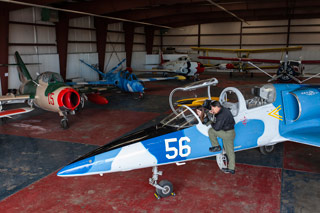 Larry Salganek, owner of Jet Warbird Training Center in Santa Fe, New Mexico, offers training in the Aero Vodochody L-29 Delfin and L-39 Albatros, Lockheed T-33 T-Bird, Fouga Magister, and Mikoyan-Gurevich MiG-15.
Larry Salganek, owner of Jet Warbird Training Center in Santa Fe, New Mexico, offers training in the Aero Vodochody L-29 Delfin and L-39 Albatros, Lockheed T-33 T-Bird, Fouga Magister, and Mikoyan-Gurevich MiG-15.
Because of the forgiving handling characteristics of the L-29 and L-39, Salganek starts pilots without jet experience in one of those before transitioning to the MiG-15. (As a flight instructor with most of my hours in a Cessna 172—and none in a jet—I start training in the L-39 combat trainer designed for low-time pilots.) The L-39, flown in the experimental category in the United States, wows crowds annually at airshows, but it’s still an active military aircraft in Africa and Eastern Europe. Pilots from around the world and of all skill levels—300-hour private pilots, former military pilots, airline captains, and corporate pilots—fly with Salganek to get a taste of flying jets, earn a rating, complete upset training, or compare jets before making a purchase. Pilots seeking a type rating in one of the jets must have an instrument rating and at least 1,000 hours total time with 500 hours as pilot in command.
 I get some extra cockpit familiarization time in the L-39 Albatros when snow and high winds scrub my first day of flight training.
I get some extra cockpit familiarization time in the L-39 Albatros when snow and high winds scrub my first day of flight training.
Although Santa Fe boasts 300-plus VFR flying days a year, snow and high winds scrubbed the first day of flight training, offering ample time for Salganek to brief me on the L-39’s systems, handling characteristics, and procedures. Like any instructor with decades of experience in an aircraft—Salganek learned to fly and instruct in the jets as a civilian, and he started teaching in the L-29 in 1993, MiG-15 in 1995, and L-39 in 1998—he predicts my performance on the following day’s flight with 100 percent accuracy. Watch for pilot-induced oscillations. “In this airplane, you’re going to think pressure not movement,” Salganek counsels. Don’t fixate on your altitude because “you’re going to climb.”
‘You’re outta here’
Salganek stands on the L-39’s step as we go over the before -tart checklist. The high-pitched whir of the sapphire starter turns to a rumble as the 3,800-pound static thrust Ivchenko AI-25TL turbofan engine fires. Salganek closes my canopy with one word of caution before he steps back to get in his seat: “Don’t leave without me.”
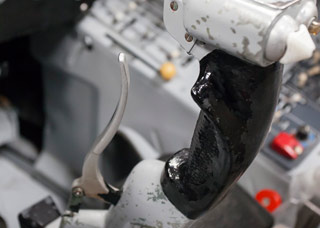 Think of squeezing the hand brake like pulling a gun trigger.
Think of squeezing the hand brake like pulling a gun trigger.
Now, the only thing between me and soaring at 400 knots true is about 4,000 feet of pavement—the taxiway. The goal: Keep the centerline between the jet’s main wheels. Taxiing the jet, even at eight to 10 mph, proves difficult to grasp because of the hand brake and lack of nosewheel steering. The pilot must fully deflect the rudder pedals (as Salganek says, “bottom it”) before squeezing the hand brake “almost like it’s a gun trigger.” Never hold the brake while moving the rudder pedals, else the jet could blow a tire.
As we taxi onto Santa Fe Municipal Airport’s 8,300-foot Runway 2, I align the L-39 on the centerline, level the rudder pedals, and hold the hand brake before running up the engine while Salganek checks the engine instruments: EGT—normal; vibration gauge—normal; spool up—normal.
“All right, put your attention outside. Just release the brakes,” he coaches. The L-39 accelerates as if released from a catapult, gaining rudder steering within seven seconds and accelerating to 100 knots just 16 seconds later for rotation. “You’re outta here,” Salganek says.
The L-39 is sensitive in pitch, and Salganek’s predictions from the day before come true. After setting an initial 10-degree nose-up pitch for takeoff and climbing a couple hundred feet, the smooth climb turns into bumbling pilot-induced oscillations for the next few thousand feet, a common over-control error among piston-single pilots when they first transition to these jets. “You’re putting in the kind of movements you would expect in a 172. You want pressure, not movement, right? So just think of pressure so we don’t get an up-and-down bobbing,” he suggests. “I fly this thing with my thumb behind it and three fingers in front of the stick. That’s all you need.”
At 130 knots, I retract the gear, followed by the flaps, and accelerate to a 180- to 200-knot climb. After 10 minutes, I settle in to the feel of the aircraft. “I can’t see your movements,” the 10,000-hour instructor says, “but I can feel your pressures coming in.” We head to the west, toward Cochiti Lake, a visible landmark breaking up the desert plateau and snow-capped mountains.
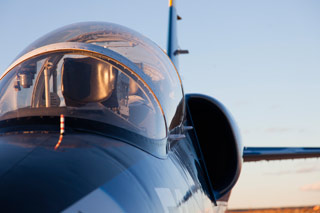 The sleek L-39 can reach speeds of Mach .78 and is still used as an active military fighter in some countries.
The sleek L-39 can reach speeds of Mach .78 and is still used as an active military fighter in some countries.
Other than taxiing, a pilot barely taps the rudders throughout a full range of maneuvers, aerobatics, and speeds. The aircraft’s responsive, light handling characteristics make what Salganek calls an “aileron airplane” so easy to fly it seems as if the aircraft’s trajectory can be controlled telepathically.
“Now she’s starting to feel like a fighter,” says Salganek, the enjoyment evident in his voice. “Now you’re cooking, 12,000 [feet] you’re doing 400 knots true.” The controls become heavier at 400-plus knots true airspeed, but with the slightest of control pressures, the aircraft rolls left, with crisp 45- and 60-degree bank turns behaving like shallow turns in a piston single. More trim is required to balance control pressures as we near Mach 0.68 during a dive. (Mmax, or maximum Mach speed, is Mach 0.78, but it would require a dive from 30,000 feet to reach that speed, Salganek says.)
The bubble canopy turns aileron rolls into an unobstructed, 360-degree tumbling view of the horizon. At 310 knots to 320 knots, the maneuver isn’t effortless; I have to grunt to apply enough stick pressure for the roll. “With a little slower airspeed it shouldn’t take quite as much force,” Salganek says, having me enter a second roll at 240 knots to 250 knots. What a difference 70 knots makes!
On the slower end of the speed spectrum, I test the trainer’s power-off glide. As we power back the jet, the aircraft becomes so quiet, the rate of descent just 1,200 fpm at 140 knots, that I feel as if I’m floating. Salganek operates at higher altitudes close enough to the airport that in the event of an engine failure he can always glide back to the runway.
‘Buzzing’ the tower
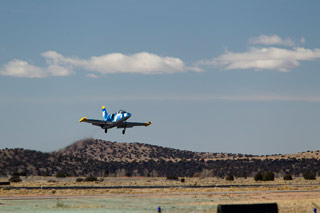 The L-39 is stable on takeoff and landing.
The L-39 is stable on takeoff and landing.
In the L-39, I aim for the 1,000-foot markers and plan to use more than half of Santa Fe’s 8,000-foot Runway 2 to land. Thankfully, the wind is straight down the runway at 11 knots. At midfield downwind, I level off at 8,000 feet, slow to 180 knots, extend the gear, and set 85-percent power. I add half flaps at 160 knots, and then slow to 140 knots and 120 knots on final with full flaps (Salganek typically teaches normal traffic patterns instead of overhead approaches). The power stays in until just before the end of the runway. While piston single pilots would never make an approach at 85-percent power, the power stays in on the jet because of the spool-up time required when going from idle to full power. “In jet we have to use pitch for airspeed because it’s too slow to correspond to a throttle setting,” he explains. To illustrate that point, while on final, Salganek quickly pushes the throttle full forward and back to idle before resuming our normal power setting—no change in airspeed. Had we left the power change in for 20 seconds, it would have had an impact, but not with quick changes.
The L-39 lands like a piston single. With the power idled just before touchdown, the key is to roll out low and bring the nose up to touch down on the main wheels. Because the jet’s wings are not visible from the front pilot’s periphery, it can be difficult to judge whether the wings are level, especially during a crosswind. I perform two go-arounds and three landings for Salganek, building my confidence each time around the pattern as the procedure becomes more familiar. The procedures for setting up the jet for landing are like most retractable-gear aircraft: midfield downwind, gear down; slow the aircraft; judge your base and final turns and flap settings; pitch for airspeed; obsessively check to make sure the gear is down and locked.
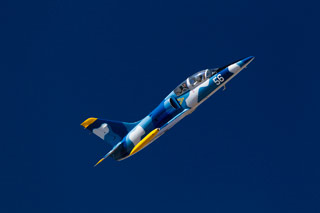 Cleared for a go around—and a steep climbing turn around Santa Fe's control tower.
Cleared for a go around—and a steep climbing turn around Santa Fe's control tower.
At the end of the L-39 training, Salganek gives me a fun, familiar exercise—one I’ve watched many times on the big screen. During a pre-coordinated go around, I roll the trainer into a steep climbing right turn around the midfield tower at Santa Fe Municipal Airport; I feel like Maverick buzzing the tower, but I’m not low enough or close enough to make the controller spill his coffee. There’s a safety margin built in for a 600-hour piston-single pilot making the leap to an L-39.
‘You have to be able to say ‘no’”
Safety margin is the key, and that’s what Salganek stresses from the moment he meets a pilot. “I’m here to teach,” he says, reiterating not to impress or scare his students. His safety record testifies that he practices what he preaches. “In 20 years of doing this, I probably have more time in these planes than anybody else in the United States, accident free,” he says. “That’s hard to do for 20 years.”
Salganek recalls stories of friends who have died in jet warbirds and of pilots’ lives he probably saved. In one case, Salganek, in his disarming, friendly manner, talked an L-39 student and instructor unfamiliar with Santa Fe’s 6,348-foot elevation out of taking off mid-afternoon on a hot summer day when the high density altitude would have made attempts to take off fatal. He drove them to a hotel near the airport and then picked them up early the next morning for a departure in cooler weather.
During training, Salganek considers himself a spiritual advisor. “You face challenges in terms of what their abilities are in flying the airplane, and what their mental outlook is toward flying the airplane,” he explains. Sometimes he helps them overcome anxieties. “You’ve gotta get them to relax them a little” but also convey a sense of caution.
 By the end of the L-39 lesson, I manage to nail the taxiway centerline—for a moment.
By the end of the L-39 lesson, I manage to nail the taxiway centerline—for a moment.
With fuel burn, for example, he says to “think of it in minutes, I think that will keep you out of trouble.” On our one-hour flight, we burn more than 1,000 pounds of jet fuel, or 160 gallons—10 percent of the jet’s weight. The aircraft holds two hours, 20 minutes of fuel between the main and tip tanks.
In addition to mentally staying ahead of the aircraft and flying within pre-established safety margins, Salganek says consistency is also key. He hands me a rubber ball and asks if I can throw it up and catch it three times. Sure, easy enough. Then, he poses a hypothetical: What if he asked me to throw it up 200 times, and the first time I dropped it, I got shot. Could I do it? Now that’s a different proposition, one analogous to stepping up to a jet warbird from the piston-single world. One runway overrun in a jet warbird, and “you’re gonna die,” Salganek says seriously.“
You’ve gotta be more than a good pilot to fly these,” he says of the importance of aeronautical decision making and stick-and-rudder skills. “You have to be able to say ‘No, that’s crazy,’” and walk away from a situation that could get you in trouble. “The word ‘maybe’ doesn’t come into play here.” That’s especially true of the MiG-15 that I’ll fly next. The Russian jet has a number of problematic handling characteristics but one redeeming quality. Find out what it is next week as I step up to the MiG-15.




